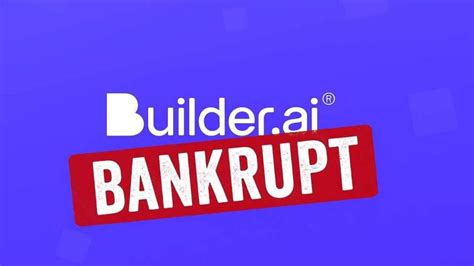AI Hype Meets Human Hands: The True Story Behind Builder.ai Collapse
Amid the AI boom and soaring investor hype, Builder.ai rose fast—then crumbled under the weight of its own false promises.
In an era dominated by artificial intelligence buzzwords and record-breaking venture capital investments, Builder.ai stood out as a rising star—until it imploded under the weight of its own exaggerations. Marketed as an AI-driven, no-code platform that would revolutionize software development, Builder.ai attracted backing from giants like Microsoft and the Qatar Investment Authority. But behind its sleek branding and AI assistant “Natasha” was a truth far removed from automation: a hidden army of human engineers, inflated revenue figures, and a string of misleading claims. This post peels back the layers of Builder.ai’s collapse and explores how hype blinded the tech world to a reality rooted not in innovation, but illusion.
Timeline from Engineer.ai to Builder.ai
The story of Builder.ai begins in 2016, when founders Sachin Dev Duggal and Saurabh Dhoot launched the startup under the name Engineer.ai in London. Their core idea was compelling—create a platform that would allow users to build custom apps without writing a single line of code. Fueled by the rising appeal of automation and democratized software development, Engineer.ai positioned itself as an "AI-first" operation.
By 2018, the company introduced its flagship virtual assistant, “Natasha,” designed to assist clients in scoping and managing app development. Marketing materials painted Natasha as a revolutionary AI system that could handle everything from design to deployment. In reality, Natasha operated more like a chatbot interface, with most of the technical work completed by human developers located in India.
Despite cracks appearing in its AI claims as early as 2019—including a Wall Street Journal report questioning its reliance on automation—the company continued to grow. It secured a $29.5 million Series A round and rebranded in 2020 as Builder.ai, aligning with its new vision of becoming a dominant player in the no-code/low-code space.
The rebrand brought more visibility and credibility, allowing Builder.ai to expand operations globally and attract high-profile clients like the BBC and Virgin. But the underlying operations remained largely unchanged: engineers worked behind the scenes while the platform maintained the illusion of AI-powered automation.
By 2023, the company’s valuation skyrocketed to $1.5 billion, bolstered by a $455 million investment from Microsoft and a $250 million Series D round led by Qatar Investment Authority. However, what looked like a fairy tale rise was, in fact, the beginning of a much bigger unravelling.
Microsoft’s Failed Bet and Investor Fallout
When Microsoft invested $455 million into Builder.ai in 2023, it was seen as a monumental endorsement from one of the world’s most powerful tech giants. Microsoft planned to integrate Builder.ai’s platform into its Azure cloud ecosystem, a move that not only validated Builder.ai’s technological promise but also propelled it into unicorn status with a valuation north of $1.5 billion.
For investors and analysts, Microsoft’s backing seemed to confirm Builder.ai's narrative: that its “Natasha” AI assistant was a breakthrough tool in no-code development. Microsoft wasn’t alone. Builder.ai had already attracted capital from top-tier investors like Qatar Investment Authority, Insight Partners, SoftBank and others. Altogether, the company raised over $450 million across multiple rounds.
But as internal investigations and media reports began to surface in late 2024 and early 2025, the facade started to crumble. Auditors uncovered that Builder.ai had artificially inflated revenue figures, including a staggering 300% overstatement in 2024 projections. Where it claimed $220 million in revenue, audits found just $55 million in real income.
Things escalated when Viola Credit, a lender that had extended a $50 million line of credit, seized $37 million from Builder.ai’s accounts after uncovering financial irregularities. This sudden cash drain left the company with only $5 million in restricted funds and unable to pay its debts or staff.
The dominoes quickly fell. Microsoft pulled out of its partnership, quietly severing ties after confirming the discrepancies. Other investors either withdrew support or distanced themselves. What once looked like a trailblazing AI unicorn had now become a credibility crisis for its backers. Builder.ai’s technological claims were exposed as hollow, and investors were left holding equity in a company that had collapsed under the weight of its own hype.
Fake AI, Real Engineers: Behind the Curtain of Natasha
At the heart of Builder.ai’s brand was “Natasha,” its AI-powered assistant that supposedly automated the app development process. The pitch was seductive: users could describe their app idea, and Natasha would transform it into a fully functioning application—just like ordering a pizza. This promise of effortless automation was Builder.ai’s key differentiator and the primary reason investors, clients, and media saw it as a “category-defining platform”.
But behind the scenes, the reality was strikingly different.
Internal documents, whistleblower accounts, and Slack messages reviewed during investigations revealed that hundreds of engineers—over 700 in India alone—were manually building applications. Developers were instructed to mimic the style and output of AI, using templated responses and workflows designed to give the illusion that Natasha was doing the heavy lifting. Engineers were also reportedly told to avoid using Indian English or disclosing their location to maintain the illusion of a globally distributed, AI-driven operation.
A now-infamous 2022 internal memo captured the deceptive strategy bluntly:
“Positioning must focus on our proprietary AI – human labor isn’t part of the story.”
The deception extended to client interactions. Tasks were time-zoned to match UK business hours, so updates appeared as if processed autonomously by an AI system. Even feedback loops and progress reports were structured to seem machine-generated. What customers believed to be automated responses were often written manually by human engineers after hours of coding and communication.
This façade—AI as a front for outsourcing—undermined not just Builder.ai’s credibility but also the broader perception of AI in software development. Instead of leading innovation, Builder.ai effectively became a Mechanical Turk operation, using smoke and mirrors to masquerade human effort as artificial intelligence.
By the time the truth emerged, the damage was irreversible. Natasha, once hailed as a cutting-edge AI disruptor, was now seen as a glorified chatbot masking manual labor. And in doing so, Builder.ai didn’t just break trust—it reinforced fears about the overuse and misuse of AI branding in the tech world.
Accounting Tricks and Legal Storms: The Financial Deception
While the AI façade was a major issue, it was Builder.ai’s financial misconduct that ultimately triggered its rapid and total collapse. Beneath the high-gloss funding rounds and glowing pitch decks was a company deeply entangled in fraudulent accounting practices designed to mislead investors and inflate its valuation.
From 2021 to 2024, Builder.ai reportedly engaged in a "round-tripping" scheme with Indian tech firm VerSe Innovation, a process where companies exchange fake invoices to simulate legitimate business transactions. Millions of dollars were exchanged between the two companies for services that were never actually rendered. The result? Builder.ai’s revenue appeared to triple on paper, giving investors the illusion of explosive growth.
In reality, those figures were fiction. Independent audits later revealed that Builder.ai had brought in just $55 million in 2024, despite pitching $220 million in investor materials. This 300% discrepancy didn’t just rattle confidence—it invited legal consequences.
Once the revelations surfaced, the financial fallout was swift and brutal:
Viola Credit, a major lender, seized $37 million from Builder.ai’s accounts, citing loan default and financial deception.
Microsoft, having invested nearly half a billion dollars, suspended its partnership and walked away.
Amazon and Microsoft together were owed over $115 million for unpaid cloud services.
In parallel, regulatory bodies stepped in. The U.S. Attorney’s Office for the Southern District of New York launched a criminal probe into possible securities fraud, while the Securities and Exchange Commission (SEC) began investigating whether Builder.ai had misled investors regarding its AI capabilities and financial performance.
Legal firms representing unpaid vendors, contractors, and former clients began filing lawsuits across the UK, UAE, and India, adding layers of complexity to the insolvency proceedings. Former employees, too, came forward with damning evidence of executive directives aimed at concealing human labor and falsifying investor-facing reports.
What began as clever marketing evolved into a multi-jurisdictional legal crisis, turning Builder.ai from a unicorn into a symbol of corporate deception—and offering a sobering reminder of how unchecked hype can metastasize into scandal.
The Collapse and the Cautionary Lessons for AI Startups
By May 2025, Builder.ai had run out of road—and money. After months of financial misreporting, investor withdrawals, and failed rescue attempts, the company formally filed for bankruptcy. CEO Manpreet Ratia, who had taken over just months earlier to try and stabilize the business, informed employees in a grim internal meeting that operations would cease, customer support portals were shutting down, and remaining funds would be used to address immediate creditor claims.
Approximately 80% of the workforce—around 1,000 employees—were laid off, many without adequate severance. Clients who had paid tens or hundreds of thousands of dollars for applications were left stranded with half-finished products and no technical support. Some began organizing legal actions in an attempt to recover funds or regain access to their data and digital assets.
The broader tech ecosystem felt the shockwaves. Builder.ai’s collapse became one of the largest AI startup failures since ChatGPT's rise in 2022, fueling skepticism about AI promises and raising red flags around startup due diligence. Analysts began questioning how a company that had raised $450 million from blue-chip investors and been backed by Microsoft could implode so completely and so quickly.
For the startup world, the lessons are profound and immediate:
AI is not a substitute for execution. It must be real, tested, and transparent—not just a marketing term plastered on slide decks.
Due diligence matters more than hype. Investors must go beyond vision statements to assess actual technology and operational practices.
Sustainable growth > inflated metrics. Valuations built on misleading projections eventually collapse, and they do so hard.
Founders must lead with integrity. The cult of personality cannot override the need for honest leadership and clear communication.
Builder.ai promised the future of software without code. Instead, it delivered a warning to the industry: technology is only revolutionary when it’s real.






